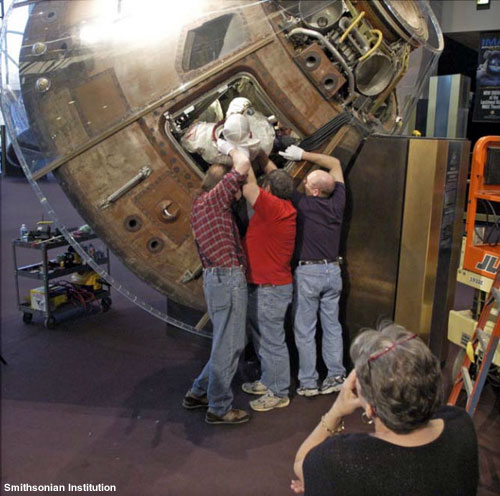Some of the Museum's most historically significant space artifacts will be removed from display this year and inspected, cleaned, and restored.
The spacesuits worn by Neil Armstrong, Michael Collins, and Buzz Aldrin on the historic Apollo 11 Moon mission are part of this effort. A fourth suit, worn by the last astronaut to walk on the Moon, Eugene Cernan, is also scheduled to be examined.
"A common misconception about spacesuits is that because they went into space they were built to be tough and last a long time," Young said. "But in truth, they were not built to last long, and we have to display them in a way that will minimize deterioration."
The Apollo 11 spacesuits have been on display in the Museum on the National Mall since the building opened in 1976. The Collins suit was visible inside the command module, Columbia, located in the Milestones of Flight gallery. This presentation allowed visitors to see the seating arrangement of an astronaut inside the cramped quarters of the space capsule.
The suits worn by the first two humans to step on the Moon, Neil Armstrong and Buzz Aldrin, have been displayed in a standing position in a glass-front diorama simulating the Moon's surface. Part of the Apollo to the Moon exhibit, the diorama features dramatic lighting and reflections of the American flag visible in the astronauts' helmet visors.
The Cernan spacesuit stands in a similar display nearby, alongside an authentic test "Moon buggy", of the same kind the astronaut drove on the Moon surface.
The Museum's spacesuit collection, some 200 or so, is the responsibility of Museum Specialist Amanda Young. She considers them to be some of the most authentic artifacts in the Museum's collection. "They are exactly as they were when they were in use," Young explains. "Nothing on them has been replaced. Also, these 'miniature spacecraft' kept our astronauts alive in the most extreme circumstances, which is quite a significant feat."
On March 15, Young supervised a team of Museum experts who, acting with great care, extracted the Michael Collins suit from Columbia. Of all the spacesuits being moved, this one presented the biggest challenge, given the suit's seated position in a confined space. After removal, which took a couple of hours, the suit was transported to the Museum's Paul E. Garber Preservation, Restoration, and Storage Facility in Suitland, Md. There it will undergo the necessary restoration and be placed in environmentally controlled storage. At this time, there are no plans to place the Collins suit on display again.
The Buzz Aldrin suit was removed one week later. After restoration, estimated to take a couple of weeks, Young will place the suit on a new mannequin, and then back in Apollo to the Moon. One aspect of the display will be changed, however. "The helmet and gloves will be placed on stands next to the suits," Young explained. "This will allow more air to circulate through the suits, which will be better for them in the long term."
The Armstrong and Cernan suits are next on Young's list. Eventually, She will focus on other spacesuits in the collection, such as John Glenn's, exhibited in the Space Race gallery.
Young is clearly enthusiastic about her role as keeper of the spacesuits. "I made the decision to look after these objects about ten years ago when I took over the collection, and with a great deal of help from some wonderful people have managed to improve their storage and display conditions," she said. "Hopefully our efforts will make a difference in the long run."













